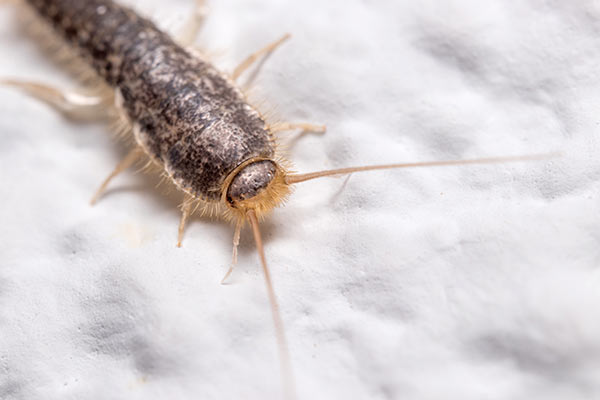Silverfish Bugs

10% OFF FOR NEW CUSTOMER, SENIORS & MILITARY. CALL TODAY

SILVERFISH, SMALL PESTS WITH A BIG APPETITE
Silverfish are a type of insect that can be found in homes and properties, and are known for their distinctive, silver-gray color and teardrop-shaped bodies. While they are not harmful to humans, silverfish can cause damage to books, clothing, and other household items, making them a nuisance for homeowners and property managers.
Silverfish often go unnoticed by homeowners, as they prefer to hide during daytime hours in dark, damp spaces. Active at night, these silver bugs often roam in particularly humid areas, including bathrooms, garages, and attics. Silverfish aren’t known to bite humans and don’t carry any diseases like many other household pests. The real threat from the pests is the damage they can cause to your belongings.
Silverfish have hefty appetites and love to feast on common household items, especially clothing and paper items. The pests love starches and protein-packed items as well and may munch on human food like grains and sugars. If left unnoticed, silverfish can destroy furniture, clothing, and even parts of the home like carpeting and wallpaper.
These pests are fairly easy to identify if you can spot them. They tend to be between 12-15mm in length and have a silver-ish color with brown and gray mixed in. Silverfish do not have wings and cannot fly. Their bodies have a unique, teardrop shape when looking from above, but are flat when seen at ground level. Towards the rear of silverfish, their bodies taper off and are covered with small, shiny scales. There is sometimes confusion between this pest and the firebrat, which is another wingless insect and has similar characteristics and diet. One of the main differences between the two is the firebrat’s preference for warm spaces. They are often found near fireplaces and heating units – or close to hot water pipes within the plumbing system.
What is most recognizable about silverfish is how they move. In fact, silverfish get their name for their “swim-like” movements. They move very quickly and often in a curve-like pattern as if they are swimming underwater. Those who’ve unexpectedly caught a glimpse of this motion can attest to its unnerving nature. It’s the main reason why the pests, though harmless to humans, warrant uneasiness when they make their presence known.
IDENTIFY AND TREAT SILVERFISH INFESTATIONS WITH REGULAR PEST INSPECTIONS
Silverfish can have long lifespans, ranging from 2-8 years generally. They reproduce quickly as well. Female silverfish often lay multiple eggs or clusters of eggs per day, year-round. Often, the pests leave these eggs in hard-to-see and reach places within the home, like cracks in floorboards or untouched attic space. Reproduction happens with homeowners not knowing, quickly leading to an infestation if not addressed.
Preventing silverfish entirely from inhabiting Florida homes and businesses is near impossible, but there are a few steps you can take to limit the chance of the pests causing an issue for you. In Florida, limiting humidity inside is a difficult task. However, keeping rooms as cool and dry as possible with air conditioning and dehumidifiers is best for creating a space that’s unappealing to these pests. Keeping spaces clean is equally as important, including regular vacuuming and limited clutter – especially in areas with less traffic like attics and basements. Stacks of books, discarded boxes, and piles of clothing all offer silverfish the perfect environment to inhabit.
Limit standing water in the home, and address instances of it as soon as possible. This means not ignoring plumbing leaks, no matter how small. While these occurrences seem minor, they create a welcoming space for silverfish if left unattended.
It’s obviously not feasible for most homeowners to keep storage areas like garages and basements completely free of items. In fact, most store unused or unneeded items in these spaces until needed again. While this is expected, what you store your items in matters. Avoid cardboard boxes when possible, as the container itself is a common meal for silverfish. Opt for plastic and choose containers with sealable lids.
Because they are nocturnal, many homeowners don’t notice a silverfish infestation until it escalates. However, some signs of the pests – other than spotting one “swimming” across the room – include noticeable damage to items in the home or spotted droppings and skin molts from the pests. Silverfish droppings look as unique as their bodies. The droppings are black and look similar to pellets or peppercorns. Noticeable damage caused by silverfish varies, but a good sign is noticeable holes in starchy items like wallpaper, clothing, and cardboard. When the pests molt, they also leave behind yellow dust that stains linens – another good sign of an infestation. Spotting even just one silverfish in the home is cause for concern, as the pests don’t live alone.
As with most other pests, the best protection against silverfish is a regular cadence of inspections, catching any issue or potential for one to arise earlier. Because pest control is very location specific, seek out a trusted local team of experts trained to handle common Florida pests, like silverfish. Regular inspections and proactive treatments by knowledgeable pest experts are the best way to prevent silverfish from taking over your home or business. Contact the team at Knockout Pest Control to schedule your next pest inspection today!
